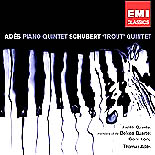Composed in 2001, Thomas Adès’ one-movement Piano Quintet contains marvelous textural ideas. These include soft high-register string chords against jagged piano lines that float from the bottom to top register, plus sections of leisurely, transparent counterpoint where each instrument stakes out its own tempo. The music seems to float and sway rather than move decisively, although a strict Sonata-Allegro game plan is at work, complete with repeat and recapitulation. The assertive, bowed violin chords that open the piece return in various transformed states, culminating in a sudden, inconclusive C major chord that marks the piece’s end. Given the Arditti Quartet’s new-music expertise and Adès’ presiding at the piano, you would assume that both performance and engineering honor the composer’s wishes.
Schubert’s “Trout” Quintet, however, is a different kettle of fish (pun intended). Adès and members of the Belcea Quartet attack the first, third, and fifth movements with a vehement quality resulting in ugly loud tuttis–a far cry from the well-defined ensemble balances we glean from numerous competing “Trout” recordings. Violinist Corina Belcea’s vibrato often borders on the unctuous, and the famous fourth-movement variations suffer from indulgent phrase taperings and tempo manipulations. Compare this flabby, ill-balanced Variation II to the recent Virgin Classics version from Renaud Capuçon and company, and hear for yourself. While Adès ably commands the not-so-easy piano part, he doesn’t match Frank Braley’s superior rhythmic élan and dynamism in both Variation III and the Finale on Virgin Classics, nor is he as supple and flexible a colorist as either Emanuel Ax (both his Sony and RCA versions) or Christian Zacharias (MDG). Mainly recommended for the Adès Quintet.
































